水利水电工程毕业设计
- 格式:doc
- 大小:1.89 MB
- 文档页数:81
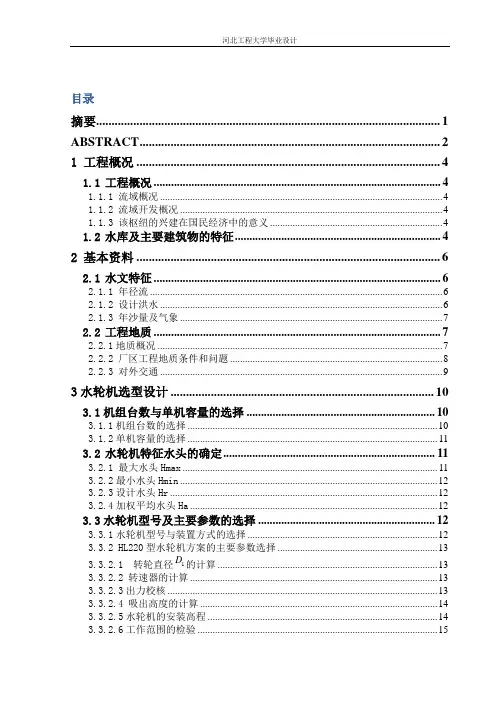
目录摘要 (1)ABSTRACT (2)1 工程概况 (4)1.1工程概况 (4)1.1.1 流域概况 (4)1.1.2 流域开发概况 (4)1.1.3 该枢纽的兴建在国民经济中的意义 (4)1.2水库及主要建筑物的特征 (4)2 基本资料 (6)2.1水文特征 (6)2.1.1 年径流 (6)2.1.2 设计洪水 (6)2.1.3 年沙量及气象 (7)2.2工程地质 (7)2.2.1地质概况 (7)2.2.2 厂区工程地质条件和问题 (8)2.2.3 对外交通 (9)3水轮机选型设计 (10)3.1机组台数与单机容量的选择 (10)3.1.1机组台数的选择 (10)3.1.2单机容量的选择 (11)3.2水轮机特征水头的确定 (11)3.2.1 最大水头Hmax (11)3.2.2最小水头Hmin (12)3.2.3设计水头Hr (12)3.2.4加权平均水头Ha (12)3.3水轮机型号及主要参数的选择 (12)3.3.1水轮机型号与装置方式的选择 (12)3.3.2 HL220型水轮机方案的主要参数选择 (13)D的计算 (13)3.3.2.1 转轮直径13.3.2.2转速器的计算 (13)3.3.2.3出力校核 (13)3.3.2.4 吸出高度的计算 (14)3.3.2.5水轮机的安装高程 (14)3.3.2.6工作范围的检验 (15)3.3.3 HL230型水轮机方案的主要参数选择 (15)3.3.3.1 转轮直径1D的计算 (15)3.3.3.2 确定水轮机的转速 (15)3.3.3.3 出力校核 (16)3.3.3.4 吸出高度的计算 (16)3.3.3.5水轮机的安装高程 (17)3.3.2.6工作范围的检验 (17)3.4蜗壳的形式和尺寸的确定 (18)3.4.1 蜗壳形式的选择 (18)3.4.2 金属蜗壳设计理论 (18)3.4.3 蜗壳尺寸的计算 (19)3.5尾水管形式和尺寸的确定 (22)3.5.1尾水管形式的选择 (22)3.5.2尾水管尺寸的确定 (22)3.6调速器和油压装置的选择 (24)3.7发电机的选择 (24)3.7.1 水轮发电机的尺寸和重量 (25)4.水电站枢纽的总体布置 (29)4.1厂房枢纽布置 (29)4.2厂房建筑物的组成 (29)4.2.1 水电站厂房建筑物的组成 (29)4.2.2 水电站厂房内部布置 (29)5水电站厂房设计 (31)5.1厂房构造 (31)5.2主厂房的上部结构 (31)5.2.1 屋顶 (31)5.2.2 构架 (31)5.2.3 吊车梁 (32)5.2.4 外墙 (32)5.2.5 楼板 (32)5.3主厂房的下部结构 (32)5.4主厂房平面设计 (32)5.4.1 主厂房长度的确定 (32)5.4.2 主厂房宽度的确定 (33)5.5主厂房剖面设计 (34)5.5.1 机组的安装高程 (34)5.5.2 尾水管顶部高程 (34)5.5.3 尾水管底板高程 (34)5.5.4 基础开挖高程 (35)5.5.5 水轮机地面高程 (35)5.5.6 主阀廊道地面高程 (35)5.5.7 发电机定子安装高程 (35)5.5.8 发电机层地面高程 (35)5.5.9 吊车轨顶高程 (35)5.5.10 天花板高程 (36)5.5.11 屋顶高程 (36)5.6副厂房的布置与设计 (36)5.6.1中央控制室 (36)5.6.2开关室和电缆室 (36)5.6.3继电保护室,载波室及其他 (37)结束语 (38)谢辞 (39)参考文献 (40)摘要本设计为向阳口二级水电站厂房设计,该电站为引水式日调节电站,在华北电网上担任峰荷与调相任务,对改变华北地区用电紧张状态,充分合理利用水能资源,缓解电力系统高峰供电的紧张状态起积极作用,向阳口II级电站的兴建,对提高京津唐电力系统的灵活性,充分利用水能,具有十分重要的意义。
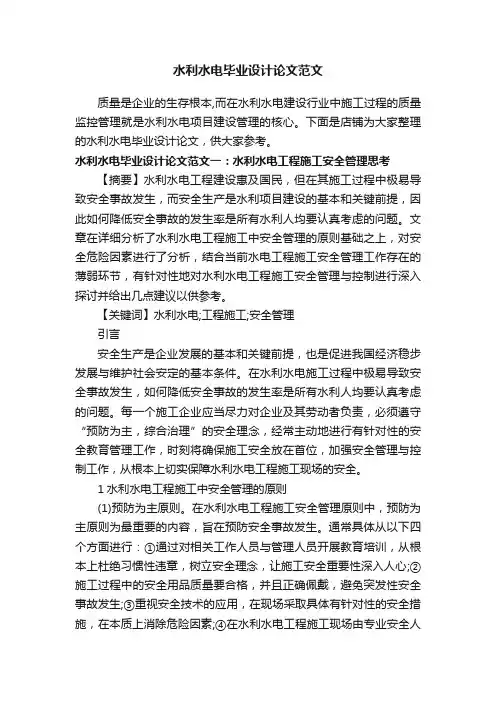
水利水电毕业设计论文范文质量是企业的生存根本,而在水利水电建设行业中施工过程的质量监控管理就是水利水电项目建设管理的核心。
下面是店铺为大家整理的水利水电毕业设计论文,供大家参考。
水利水电毕业设计论文范文一:水利水电工程施工安全管理思考【摘要】水利水电工程建设惠及国民,但在其施工过程中极易导致安全事故发生,而安全生产是水利项目建设的基本和关键前提,因此如何降低安全事故的发生率是所有水利人均要认真考虑的问题。
文章在详细分析了水利水电工程施工中安全管理的原则基础之上,对安全危险因素进行了分析,结合当前水电工程施工安全管理工作存在的薄弱环节,有针对性地对水利水电工程施工安全管理与控制进行深入探讨并给出几点建议以供参考。
【关键词】水利水电;工程施工;安全管理引言安全生产是企业发展的基本和关键前提,也是促进我国经济稳步发展与维护社会安定的基本条件。
在水利水电施工过程中极易导致安全事故发生,如何降低安全事故的发生率是所有水利人均要认真考虑的问题。
每一个施工企业应当尽力对企业及其劳动者负责,必须遵守“预防为主,综合治理”的安全理念,经常主动地进行有针对性的安全教育管理工作,时刻将确保施工安全放在首位,加强安全管理与控制工作,从根本上切实保障水利水电工程施工现场的安全。
1水利水电工程施工中安全管理的原则(1)预防为主原则。
在水利水电工程施工安全管理原则中,预防为主原则为最重要的内容,旨在预防安全事故发生。
通常具体从以下四个方面进行:①通过对相关工作人员与管理人员开展教育培训,从根本上杜绝习惯性违章,树立安全理念,让施工安全重要性深入人心;②施工过程中的安全用品质量要合格,并且正确佩戴,避免突发性安全事故发生;③重视安全技术的应用,在现场采取具体有针对性的安全措施,在本质上消除危险因素;④在水利水电工程施工现场由专业安全人员对施工现场进行巡查,及时发现一些潜在的危险因素,在最大程度上予以施工安全保障。
(2)安全优先原则。
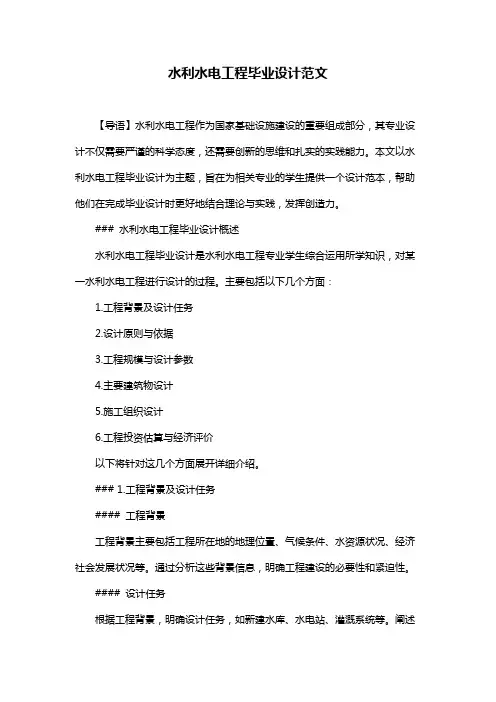
水利水电工程毕业设计范文【导语】水利水电工程作为国家基础设施建设的重要组成部分,其专业设计不仅需要严谨的科学态度,还需要创新的思维和扎实的实践能力。
本文以水利水电工程毕业设计为主题,旨在为相关专业的学生提供一个设计范本,帮助他们在完成毕业设计时更好地结合理论与实践,发挥创造力。
### 水利水电工程毕业设计概述水利水电工程毕业设计是水利水电工程专业学生综合运用所学知识,对某一水利水电工程进行设计的过程。
主要包括以下几个方面:1.工程背景及设计任务2.设计原则与依据3.工程规模与设计参数4.主要建筑物设计5.施工组织设计6.工程投资估算与经济评价以下将针对这几个方面展开详细介绍。
### 1.工程背景及设计任务#### 工程背景工程背景主要包括工程所在地的地理位置、气候条件、水资源状况、经济社会发展状况等。
通过分析这些背景信息,明确工程建设的必要性和紧迫性。
#### 设计任务根据工程背景,明确设计任务,如新建水库、水电站、灌溉系统等。
阐述工程的主要功能、服务对象以及预期效益。
### 2.设计原则与依据#### 设计原则遵循国家相关法律法规、技术规范和标准,确保工程安全、经济、适用、美观。
#### 设计依据主要包括国家及行业的相关法律法规、技术规范、工程可行性研究报告、地形地质资料等。
### 3.工程规模与设计参数根据设计任务和设计原则,合理确定工程规模和设计参数,如水库库容、电站装机容量、灌溉面积等。
### 4.主要建筑物设计#### 水工建筑物设计包括坝体、泄洪建筑物、引水建筑物、水电站厂房等,阐述各建筑物的设计原则、结构类型、设计参数等。
#### 土建工程设计包括道路、桥梁、隧道等,介绍其设计原则、结构形式、技术参数等。
### 5.施工组织设计分析施工条件,制定合理的施工组织方案,包括施工方法、施工进度、施工管理等。
### 6.工程投资估算与经济评价根据设计成果,进行工程投资估算,并对工程经济效益、社会效益和环境效益进行评价。
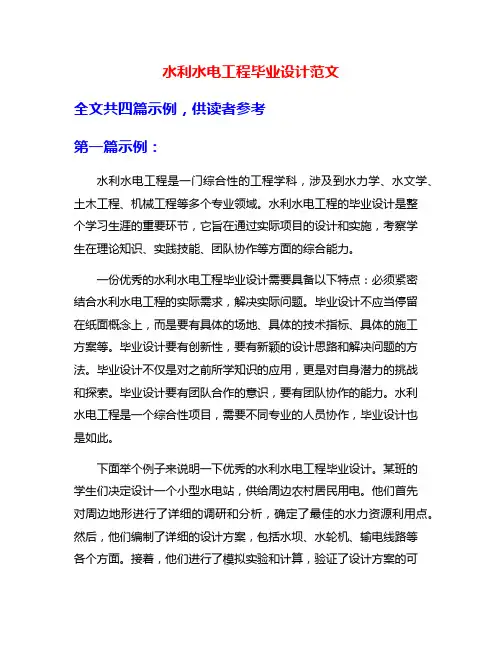
水利水电工程毕业设计范文全文共四篇示例,供读者参考第一篇示例:水利水电工程是一门综合性的工程学科,涉及到水力学、水文学、土木工程、机械工程等多个专业领域。
水利水电工程的毕业设计是整个学习生涯的重要环节,它旨在通过实际项目的设计和实施,考察学生在理论知识、实践技能、团队协作等方面的综合能力。
一份优秀的水利水电工程毕业设计需要具备以下特点:必须紧密结合水利水电工程的实际需求,解决实际问题。
毕业设计不应当停留在纸面概念上,而是要有具体的场地、具体的技术指标、具体的施工方案等。
毕业设计要有创新性,要有新颖的设计思路和解决问题的方法。
毕业设计不仅是对之前所学知识的应用,更是对自身潜力的挑战和探索。
毕业设计要有团队合作的意识,要有团队协作的能力。
水利水电工程是一个综合性项目,需要不同专业的人员协作,毕业设计也是如此。
下面举个例子来说明一下优秀的水利水电工程毕业设计。
某班的学生们决定设计一个小型水电站,供给周边农村居民用电。
他们首先对周边地形进行了详细的调研和分析,确定了最佳的水力资源利用点。
然后,他们编制了详细的设计方案,包括水坝、水轮机、输电线路等各个方面。
接着,他们进行了模拟实验和计算,验证了设计方案的可行性。
他们分工合作,按照计划开始了实施。
整个过程中,每个人都扮演着不同的角色,协作配合,最终成功地完成了水电站的建设。
这个例子展示了一个优秀的水利水电工程毕业设计的特点。
他们紧密结合实际需求,解决了周边农村居民用电的问题。
他们具备创新精神,利用最优的资源进行设计。
他们有良好的团队合作精神,共同完成了设计和实施。
这正是一个优秀的水利水电工程毕业设计所应具备的品质。
水利水电工程毕业设计是一个全面考察学生能力的重要环节。
只有紧密结合实际需求,具备创新意识,拥有团队合作精神,才能完成一份优秀的毕业设计。
希望每位水利水电工程的学子都能在毕业设计中有所收获,展现自己的才华和能力。
祝每位学子顺利毕业!第二篇示例:水利水电工程毕业设计范文一、设计背景水利水电工程是指利用水资源,对水资源进行开发利用,解决工农业生产和人民日常生活中的用水问题,以及发电、防洪等方面的工程建设。
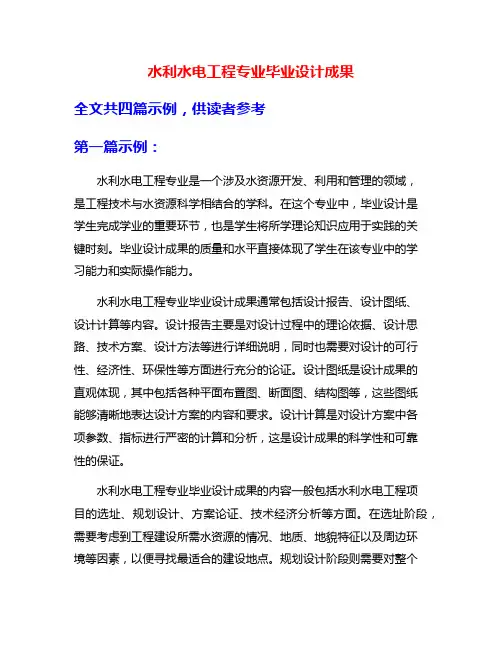
水利水电工程专业毕业设计成果全文共四篇示例,供读者参考第一篇示例:水利水电工程专业是一个涉及水资源开发、利用和管理的领域,是工程技术与水资源科学相结合的学科。
在这个专业中,毕业设计是学生完成学业的重要环节,也是学生将所学理论知识应用于实践的关键时刻。
毕业设计成果的质量和水平直接体现了学生在该专业中的学习能力和实际操作能力。
水利水电工程专业毕业设计成果通常包括设计报告、设计图纸、设计计算等内容。
设计报告主要是对设计过程中的理论依据、设计思路、技术方案、设计方法等进行详细说明,同时也需要对设计的可行性、经济性、环保性等方面进行充分的论证。
设计图纸是设计成果的直观体现,其中包括各种平面布置图、断面图、结构图等,这些图纸能够清晰地表达设计方案的内容和要求。
设计计算是对设计方案中各项参数、指标进行严密的计算和分析,这是设计成果的科学性和可靠性的保证。
水利水电工程专业毕业设计成果的内容一般包括水利水电工程项目的选址、规划设计、方案论证、技术经济分析等方面。
在选址阶段,需要考虑到工程建设所需水资源的情况、地质、地貌特征以及周边环境等因素,以便寻找最适合的建设地点。
规划设计阶段则需要对整个工程项目进行全面的布局设计,考虑到各个部分之间的协调性和整体性。
而方案论证则是对不同设计方案进行对比分析,找出最为合理和可行的设计方案。
技术经济分析是对设计方案的成本、投入产出比等进行详细的分析,确保工程项目在技术上和经济上都具有可行性。
在未来的发展中,水利水电工程专业毕业设计成果还将面临更多的挑战和机遇。
随着科技的不断进步和社会的发展,水利水电工程领域也在发生着巨大变化,新技术、新理念的应用将会对毕业设计成果提出更高的要求。
在国家对水资源的管理和保护要求越来越高的背景下,毕业设计成果也需要更加注重可持续性发展、节能减排等方面的考虑。
水利水电工程专业毕业设计成果是学生学习成果的重要体现,它对学生的综合能力和专业素养进行考核,同时也对学生今后的职业发展起到重要的指导作用。
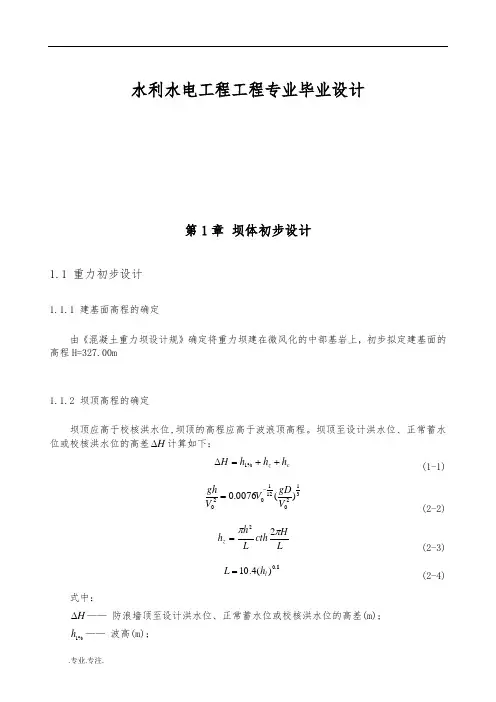
水利水电工程工程专业毕业设计第1章 坝体初步设计1.1 重力初步设计1.1.1 建基面高程的确定由《混凝土重力坝设计规》确定将重力坝建在微风化的中部基岩上,初步拟定建基面的高程H=327.00m1.1.2 坝顶高程的确定坝顶应高于校核洪水位,坝顶的高程应高于波浪顶高程。
坝顶至设计洪水位、正常蓄水位或校核洪水位的高差H ∆计算如下:cz h h h H ++=∆%1 (1-1)3120121020)(0076.0V gD V V gh -= (2-2)L HcthLh h z ππ22=(2-3)8.0)(4.10l h L = (2-4)式中:H ∆—— 防浪墙顶至设计洪水位、正常蓄水位或校核洪水位的高差(m);%1h —— 波高(m);z h —— 波浪中兴线至设计洪水位、正常蓄水位或校核洪水位的高差(m); c h —— 安全加高,按表1.1采用;o V —— 计算风速,水库正常蓄水位时和设计洪水位时采用相应季节50年的最大风速,校核洪水位采用相应洪水期最大风速(m/s);D —— 风区长度(m);h —— 当250~20/20=V gD 时,为累计频率5%的波高%5h ,当1000~250/20=V gD 时,为累计频率10%的波高%10h (m); H —— 坝迎水面水深(m); L —— 波长(m)。
表1.1 安全超高(m)坝顶高程H=max ⎪⎩⎪⎨⎧∆+∆+∆+校设蓄校核洪水位设计洪水位正常蓄水位hh h(1) 正常蓄水位时的计算m B D 75.112635.22555=⨯==m h V gD V V gh 468.08.9/14)1475.11268.9(140076.0)(0076.023121213120121020=⨯⨯⨯=⇒=-- 由于 561475.11268.9220=⨯=V gD ,则m h h 468.0%5== 将%5h 转换为%1h :不同累计频率P(%)下的波高p h 可由平均波高与平均水深的比值和相应的累积频率按表1.2中规定的系数计算求得。
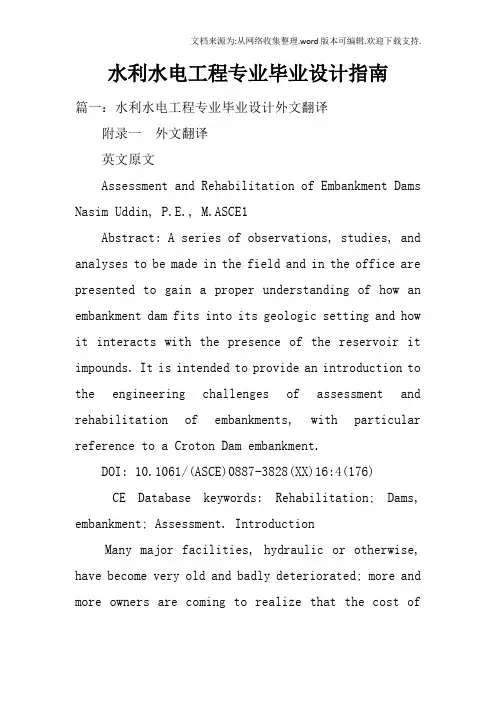
水利水电工程专业毕业设计指南篇一:水利水电工程专业毕业设计外文翻译附录一外文翻译英文原文Assessment and Rehabilitation of Embankment Dams Nasim Uddin, P.E., M.ASCE1Abstract: A series of observations, studies, and analyses to be made in the field and in the office are presented to gain a proper understanding of how an embankment dam fits into its geologic setting and how it interacts with the presence of the reservoir it impounds. It is intended to provide an introduction to the engineering challenges of assessment and rehabilitation of embankments, with particular reference to a Croton Dam embankment.DOI: 10.1061/(ASCE)0887-3828(XX)16:4(176)CE Database keywords: Rehabilitation; Dams, embankment; Assessment. IntroductionMany major facilities, hydraulic or otherwise, have become very old and badly deteriorated; more and more owners are coming to realize that the cost ofrestoring their facilities is taking up a significant fraction of their operating budgets. Rehabilitation is, therefore, becoming a major growth industry for the future. In embankment dam engineering, neither the foundation nor the fills are premanufactured to standards or codes, and their performance correspondingly is never 100% predictable. Dam engineering—in particular, that related to earth structures—has evolved on many fronts and continues to do so, particularly in thecontext of the economical use of resources and the determination of acceptable levels of risk. Because of this, therefore, there remains a wide variety of opinion and practice among engineers working in the field. Many aspects of designing and constructing dams will probably always fall within that group of engineering problems for which there are no universally accepted or uniquely correct procedures.In spite of advances in related technologies, however, it is likely that the building of embankments and therefore their maintenance, monitoring, andassessment will remain an empirical process. It is, therefore, difficult to conceive of a set of rigorous assessment procedures for existing dams, if there are no design codes. Many agencies (the U.S. Army Corps of Engineers, USBR, Tennessee Valley Authority, FERC, etc.) have developed checklists for field inspections, for example, and suggested formats and topics for assessment reporting. However, these cannot be taken as procedures; they serve as guidelines, reminders, and examples of what to look for and report on, but they serve as no substitute for an experienced, interested, and observant engineering eye. Several key factors should be examined by the engineer in the context of the mandate agreed upon with the dam owner, and these together with relevant and appropriate computations of static and dynamic stability form the basis of the assessment. It is only sensible for an engineer to commit to the evaluation of the condition of, or the assessment of, an existing and operating dam if he/she is familiar and comfortable with the design and construction of such things and furthermore hasdemonstrated his/her understanding and experience.Rehabilitation MeasuresThe main factors affecting the performance of an embankment dam are(1)seepage; (2)stability; and (3) freeboard. For an embankment dam, all of thesefactors are interrelated. Seepage may cause erosion and piping, which may lead to instability. Instability may cause cracking, which, in turn, may cause piping and erosion failures. The measures taken to improve the stability of an existing dam against seepage and piping will depend on the location of the seepage (foundation or embankment), the seepage volume, and its criticality. Embankment slope stability is usually improved by ?attening the slopes or providing a toe berm. This slope stabilization is usually combined with drainage measures at the downstream toe. If the stability of the upstream slope under rapid drawdown conditions is of concern, then further analysis and/or monitoring of resulting pore pressures or modi?cations of reservoir operationsmay eliminate or reduce these concerns. Finally, raising an earth ?ll dam is usually a relatively straightforward ?ll placement operation, especially if the extent of the raising is relatively small. The interface between the old and new ?lls must be given close attention both in design and construction to ensure the continuity of the impervious element and associated filters. Relatively new materials, such as the impervious geomembranes and reinforced earth, have been used with success in raising embankment dams. Rehabilitation of an embankment dam, however, is rarely achieved by a single measure. Usually a combination of measures, such as the installation of a cutoff plus a pressure relief system, is used. In rehabilitation work, the effectiveness of the repairs is difficult to predict; often, a phased approach to the work is necessary, with monitoring and instrumentation evaluated as the work proceeds. In the rehabilitation of dams, the security of the existing dam must be an overriding concern. It is not uncommon for the dam to have suffered significant distress—often due to thedeficiencies that the rehabilitation measures are to address.The dam may be in poor condition at the outset and may possibly be in amarginally stable condition. Therefore, how the rehabilitation work may change the present conditions, both during construction and in the long term, must be assessed, to ensure that it does not adversely affect the safety of the dam. In the following text, a case study is presented as an introduction to the engineering challenges of embankment rehabilitation, with particular reference to the Croton Dam Project.Case StudyThe Croton Dam Project is located on the Muskegon River in Michigan. The project is owned and operated by the Consumer Power Company. The project structures include two earth embankments, a gated spillway, and a concrete and masoy powerhouse. The earth embankments of this project were constructed of sand with concrete core walls. The embankments were built using a modified hydraulic fill method. This method consisted of dumpingthe sand and then sluicing the sand into the desired location. Croton Dam is classified as a ??high-hazard ‘‘ dam and is in earthquake zone 1. As part of the FERC Part 12 Inspection (FERC 1993), an evaluation of the seismic stability was performed for the downstream slope of the left embankment at Croton Dam. The Croton Dam embankment was analyzed in the following manner. Soil parameters were chosen based on standard penetration (N) values and laboratory tests, and a seismic study was carried out to obtain the design earthquake. Using the chosen soil properties, a static finite-element study was conducted to evaluate the existing state of stress in the embankment. Then a one-dimensional dynamic analysis was conducted to determine the stress induced bythe design earthquake shaking. The available strength was compared with expected maximum earthquake conditions so that the stability of the embankment during and immediately after an earthquake could be evaluated. The evaluation showed that theembankment had a strong potential to liquefy andfail during the design earthquake. The minimum soil strength required to eliminate the liquefaction potential was then determined, and a recommendation was made to strengthen the embankment soils by insitu densification.Seismic EvaluationTwo modes of failure were considered in the analyses—namely, loss of stability and excessive deformations of the embankment. The following analyses were carried out in succession: (1) Determination of pore water pressure buildup immediately following the design earthquake; (2) estimation of strength for the loose foundation layer during and immediately following the earthquake; (3) analysis of the loss of stability for postearthquake loading where the loose sand layer in the embankment is completely liquefied; and (4) liquefaction impact analysis for the loose sand layer for which the factor of safety against liquefaction is unsatisfactory.Liquefaction Impact AssessmentBased on the average of the corrected SPT value andcyclic stress ratio (Tokimatsu and Seed 1987), a total settlement of the 4.6 m(15 ft) thick loose embankment layer due to complete liquefaction was found to be 0.23 m (0.75 ft).Permanent Deformation AnalysisBased on a procedure by Makdisi and Seed (1977), permanent deformation can be calculated using the yield acceleration, and the time history of the averaged induced acceleration. Since the factor of safety against flow failure immediately following the earthquake falls well short of that required by FERC, the Newmark type篇二:水利水电专业毕业设计(1)某某学院毕业设计(论文)专业题目:毕业时间:学生姓名:指导教师:班级:XX年 12月12日1学院 XX 届水利水电工程管理专业毕业论文(设计)成绩评定表说明:1、以上各栏必须按要求逐项填写.。

水利水电工程工程专业毕业设计第1章 坝体初步设计1.1 重力初步设计1.1.1 建基面高程的确定由《混凝土重力坝设计规》确定将重力坝建在微风化的中部基岩上,初步拟定建基面的高程H=327.00m1.1.2 坝顶高程的确定坝顶应高于校核洪水位,坝顶的高程应高于波浪顶高程。
坝顶至设计洪水位、正常蓄水位或校核洪水位的高差H ∆计算如下:cz h h h H ++=∆%1 (1-1)3120121020)(0076.0V gD V V gh -= (2-2)L HcthLh h z ππ22=(2-3)8.0)(4.10l h L = (2-4)式中:H ∆—— 防浪墙顶至设计洪水位、正常蓄水位或校核洪水位的高差(m);%1h —— 波高(m);z h —— 波浪中兴线至设计洪水位、正常蓄水位或校核洪水位的高差(m); c h —— 安全加高,按表1.1采用;o V —— 计算风速,水库正常蓄水位时和设计洪水位时采用相应季节50年的最大风速,校核洪水位采用相应洪水期最大风速(m/s);D —— 风区长度(m);h —— 当250~20/20=V gD 时,为累计频率5%的波高%5h ,当1000~250/20=V gD 时,为累计频率10%的波高%10h (m); H —— 坝迎水面水深(m); L —— 波长(m)。
表1.1 安全超高(m)坝顶高程H=max ⎪⎩⎪⎨⎧∆+∆+∆+校设蓄校核洪水位设计洪水位正常蓄水位hh h(1) 正常蓄水位时的计算m B D 75.112635.22555=⨯==m h V gD V V gh 468.08.9/14)1475.11268.9(140076.0)(0076.023121213120121020=⨯⨯⨯=⇒=-- 由于 561475.11268.9220=⨯=V gD ,则m h h 468.0%5== 将%5h 转换为%1h :不同累计频率P(%)下的波高p h 可由平均波高与平均水深的比值和相应的累积频率按表1.2中规定的系数计算求得。
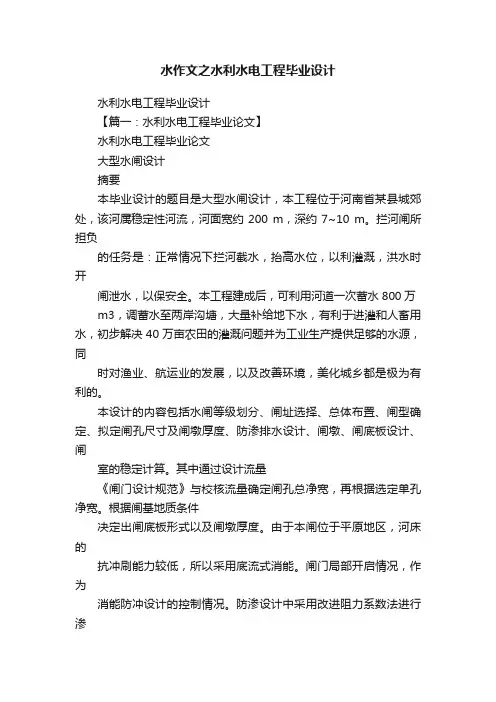
水作文之水利水电工程毕业设计水利水电工程毕业设计【篇一:水利水电工程毕业论文】水利水电工程毕业论文大型水闸设计摘要本毕业设计的题目是大型水闸设计,本工程位于河南省某县城郊处,该河属稳定性河流,河面宽约200 m,深约7~10 m。
拦河闸所担负的任务是:正常情况下拦河截水,抬高水位,以利灌溉,洪水时开闸泄水,以保安全。
本工程建成后,可利用河道一次蓄水800万m3,调蓄水至两岸沟塘,大量补给地下水,有利于进灌和人畜用水,初步解决40万亩农田的灌溉问题并为工业生产提供足够的水源,同时对渔业、航运业的发展,以及改善环境,美化城乡都是极为有利的。
本设计的内容包括水闸等级划分、闸址选择、总体布置、闸型确定、拟定闸孔尺寸及闸墩厚度、防渗排水设计、闸墩、闸底板设计、闸室的稳定计算。
其中通过设计流量《闸门设计规范》与校核流量确定闸孔总净宽,再根据选定单孔净宽。
根据闸基地质条件决定出闸底板形式以及闸墩厚度。
由于本闸位于平原地区,河床的抗冲刷能力较低,所以采用底流式消能。
闸门局部开启情况,作为消能防冲设计的控制情况。
防渗设计中采用改进阻力系数法进行渗流计算。
闸室的稳定计算中考虑到了完建无水期和正常挡水期两种情况下的荷载组合进行验算。
关键词:闸门、闸墩、消力池、渗流、地基承载力、稳定计算abstractthe school design on the topic of major flood gate design. this project is located in henan province a county and city outskirts. the river is stability river. river width of about 200m, about 7 to 10m. the river gate the tasks are: under normal circumstances the river damming water to raise water for irrigation, flood,open the gate sluicing to ensure safety. this project is completed, and you can use river a water 8 million m 3, to water and the two sides of tong, a large supply underground water, and conducive to irrigation and irrigation water, has initially solved 400,000 mu of farmland irrigation and industrial production to provide sufficient water for fishing, shipping industry, and improve the environment and beautify urban and rural areas are extremely beneficial.the design of the sluice gates hierarchy, site selection, overall arrangements, gates, established in gate hole size and design gate tun thickness, impermeable drainage design, gates tun, gates plate design, lock the stable basis. the adoption of the design of the flow of traffic nuclear school gates hole the total net width, selected in accordance with single hole net wide. in accordance with the base gate conditions on board the gates and gate tun thickness. the gate is located in the plains, river plate of resistance against soil erosion is comparatively low,so the bottom streaming consumer. gates partially open, as a consumer can prevent chong design of the situation undercontrol. impermeable design of the adoption of improved resistance coefficient of seepage. lock the stable basis, taking into account the end up without water and normal and water for two of the load combination residue.keywords :gates, gates tun, stilling basin, transfusion,foundation capacity, stable basis目录第一章总论第一节闸位概述一、工程概况本工程位于河南省某县城郊处,它是某河流梯级开发中最末一级工程。
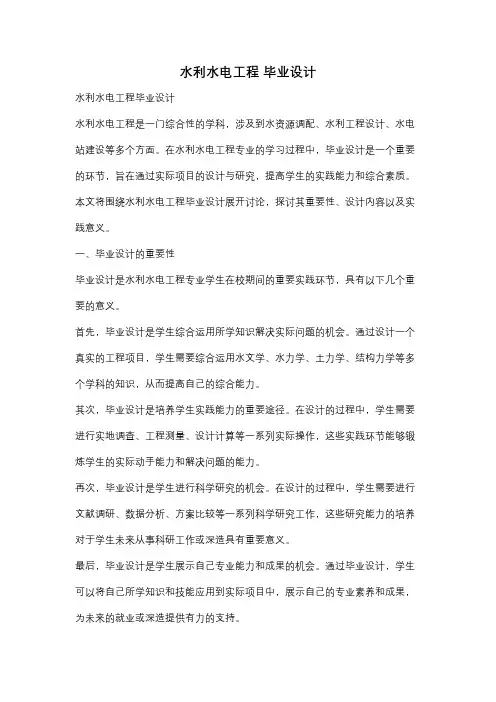
水利水电工程毕业设计水利水电工程毕业设计水利水电工程是一门综合性的学科,涉及到水资源调配、水利工程设计、水电站建设等多个方面。
在水利水电工程专业的学习过程中,毕业设计是一个重要的环节,旨在通过实际项目的设计与研究,提高学生的实践能力和综合素质。
本文将围绕水利水电工程毕业设计展开讨论,探讨其重要性、设计内容以及实践意义。
一、毕业设计的重要性毕业设计是水利水电工程专业学生在校期间的重要实践环节,具有以下几个重要的意义。
首先,毕业设计是学生综合运用所学知识解决实际问题的机会。
通过设计一个真实的工程项目,学生需要综合运用水文学、水力学、土力学、结构力学等多个学科的知识,从而提高自己的综合能力。
其次,毕业设计是培养学生实践能力的重要途径。
在设计的过程中,学生需要进行实地调查、工程测量、设计计算等一系列实际操作,这些实践环节能够锻炼学生的实际动手能力和解决问题的能力。
再次,毕业设计是学生进行科学研究的机会。
在设计的过程中,学生需要进行文献调研、数据分析、方案比较等一系列科学研究工作,这些研究能力的培养对于学生未来从事科研工作或深造具有重要意义。
最后,毕业设计是学生展示自己专业能力和成果的机会。
通过毕业设计,学生可以将自己所学知识和技能应用到实际项目中,展示自己的专业素养和成果,为未来的就业或深造提供有力的支持。
二、水利水电工程毕业设计的内容水利水电工程毕业设计的内容通常包括以下几个方面。
首先,项目背景与需求分析。
在设计之前,需要对项目的背景和需求进行充分的了解和分析,包括项目的地理环境、水资源状况、用水需求等,从而为后续的设计提供依据。
其次,方案设计与比选。
在设计过程中,需要提出多个方案,并进行比较和评估,选取最优方案。
方案设计包括水利工程的布置、水电站的选址、水电站的类型选择等。
再次,工程计算与分析。
在方案确定之后,需要进行各种工程计算和分析,包括水力计算、土力计算、结构计算等。
这些计算和分析是确保工程安全可靠的基础。
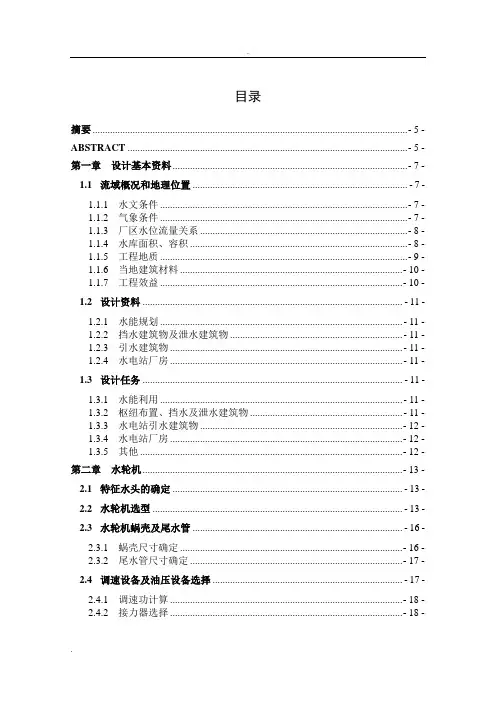
目录摘要 .............................................................................................................................. - 5 - ABSTRACT ................................................................................................................ - 5 - 第一章设计基本资料.............................................................................................. - 7 - 1.1流域概况和地理位置 .. (7)1.1.1 水文条件 ................................................................................................... - 7 -1.1.2 气象条件 ................................................................................................... - 7 -1.1.3 厂区水位流量关系 ................................................................................... - 8 -1.1.4 水库面积、容积 ....................................................................................... - 8 -1.1.5 工程地质 ................................................................................................... - 9 -1.1.6 当地建筑材料 ......................................................................................... - 10 -1.1.7 工程效益 ................................................................................................. - 10 - 1.2设计资料 .. (11)1.2.1 水能规划 ................................................................................................. - 11 -1.2.2 挡水建筑物及泄水建筑物 ..................................................................... - 11 -1.2.3 引水建筑物 ............................................................................................. - 11 -1.2.4 水电站厂房 ............................................................................................. - 11 - 1.3设计任务 .. (11)1.3.1 水能利用 ................................................................................................. - 11 -1.3.2 枢纽布置、挡水及泄水建筑物 ............................................................. - 11 -1.3.3 水电站引水建筑物 ................................................................................. - 12 -1.3.4 水电站厂房 ............................................................................................. - 12 -1.3.5 其他 ......................................................................................................... - 12 - 第二章水轮机 ........................................................................................................ - 13 - 2.1特征水头的确定 .. (13)2.2水轮机选型 (13)2.3水轮机蜗壳及尾水管 (16)2.3.1 蜗壳尺寸确定 ......................................................................................... - 16 -2.3.2 尾水管尺寸确定 ..................................................................................... - 17 - 2.4调速设备及油压设备选择 . (17)2.4.1 调速功计算 ............................................................................................. - 18 -2.4.2 接力器选择 ............................................................................................. - 18 -2.4.3 调速器的选择 ......................................................................................... - 19 -2.4.4 油压装置 ................................................................................................. - 19 - 第三章发电机 ........................................................................................................ - 21 - 3.1发电机的尺寸估算 . (21)3.1.1 主要尺寸估算 ......................................................................................... - 21 -3.1.2 外形尺寸估算 ......................................................................................... - 22 - 3.2发电机重量估算 .. (23)第四章混凝土重力坝 ............................................................................................ - 25 - 4.1剖面设计 .. (25)4.1.1 坝高的确定 ............................................................................................. - 25 -4.1.2 坝底宽度的确定 ..................................................................................... - 27 - 4.2稳定与强度校核 .. (28)4.2.1 作用组合和类型 ..................................................................................... - 29 -4.2.2 承载能力极限状态强度和稳定验算 ..................................................... - 34 -4.2.3 正常使用极限状态进行强度的计算和验算。
本科毕业论文(设计)论文(设计)题目:《七家田水电站设计》学院:土木工程学院专业:水利水电工程班级:水电112班学号: **********学生姓名:***指导教师:***2015年6月5日贵州大学本科毕业设计诚信责任书本人郑重声明:本人所呈交的毕业设计,是在导师的指导下独立进行研究所完成。
毕业论文(设计)中凡引用他人已经发表或未发表的成果、数据、观点等,均已明确注明出处。
特此声明。
设计作者签名:余官荣日期:2015 年6月5日目录1.摘要 (1)2.前言 (2)3.方案比较 (3)3.1坝址选择 (3)3.2厂址选择 (7)3.3坝型选择 (7)4.枢纽布置 (9)4.1坝体布置 (9)4.2取水口布置 (9)4.3厂房和公路布置 (10)5.坝高的确定 (10)5.1水文资料 (10)5.2 坝区工程地质资料 (24)6.应力计算 (27)6.1正常蓄水位加温降 (27)6.2设计洪水位加温降 (28)6.3校核洪水位加温降 (28)7.坝肩稳定计算 (28)7.1稳定分析方法 (28)7.2稳定计算方法 (28)7.3计算结果 (30)8.溢流坝段设计 (30)8.1溢流曲线 (30)8.2闸孔设计 (31)8.3消能设计 (31)9.冲沙底孔设计 (31)10.进水口设计 (32)11.厂房设计 (32)11.1概况及基本资料 (32)11.2厂区枢纽平面布置 (35)11.3主厂房设计 (36)12.结论 (38)13参考文献 (39)14致谢 (40)15.附录 (40)15.1坝顶高程确定 (40)15.1.特征水位计算 (40)15.1.2坝顶高程 (43)15.2拱冠梁设计计算 (45)15.2.1坝底高程 (45)15.2..2坝底厚度 (45)15.2.3确定上游面曲线 (45)15.2.4拱圈厚度曲线 (45)15.2.5圆心连线的无确定 (46)15.2.6顶拱半径图 (47)15.2.7坝体左岸半边拱的圆心连线 (48)15.2.8坝体右岸半边拱的圆心连线 (48)15.3应力计算 (50)15.3.1正常蓄水位加温降,左半拱 (50)15.3.2正常蓄水位加温降,右半拱 (55)15.3.3设计洪水位加温降,左半拱 (59)15.3.4设计洪水位加温降,右半拱 (65)15.3.5校核洪水位加温降,左半拱 (69)15.3.6校核洪水位加温降,右半拱 (75)15.4坝肩稳定计算 (79)15.4.1正常蓄水位加温降,左半拱 (81)15.4.2设计洪水位加温降,左半拱 (82)15.4.3校核洪水位加温降,左半拱 (83)15.4.4正常蓄水位加温降,右半拱 (84)15.4.5设计洪水位加温降,右半拱 (84)15.4.6校核洪水位加温降,右半拱 (85)15.5溢流剖面计算 (86)15.5.1顶部曲线段 (86)15.5.2溢流面大样图 (87)15.5.3挑距计算 (88)15.5.4冲坑深度计算 (89)15.5.5综上 (90)15.6进水口设计 (90)15.6.1压力钢管直径计算 (90)15.6.2最小淹没深度计算 (90)15.6.3调压井计算 (91)15.7厂房尺寸计算 (91)1.摘要:本设计为一个水电站的设计,主要设计水电站水工部分,不涉及电方面。
水利水电毕业设计水利水电是指通过水流来生成电力的一种能源。
水利水电毕业设计旨在探索如何利用水力资源来发电,以满足社会对电力的需求,同时兼顾环境保护的要求。
以下是一份关于水利水电毕业设计的700字报告:水利水电毕业设计报告一、选题背景随着工业化的快速发展,能源需求不断增加,传统能源的使用已经无法满足社会的需求。
而水利水电作为一种清洁可再生能源,具有资源丰富、环境友好等优点,成为了一个重要的能源替代品。
因此,本设计选题为“水利水电发电机组的设计与优化”。
二、设计目的1.研究水利水电发电机组的工作原理和关键技术;2.设计高效的水利水电发电机组,提高发电效率和能源利用率;3.探索水利水电发电的环境影响及其防护措施,保护自然生态。
三、设计方法1.收集和分析水利水电发电的相关资料和案例,了解当前的发电技术;2.进行数值模拟和实验研究,优化发电机组的结构和操作参数;3.评估水利水电发电对周边环境的影响,并设计适当的防护措施。
四、设计内容1.设计水利水电发电机组的主要组成部分,包括水轮机、发电机、水管路等;2.优化水利水电发电机组的结构,提高发电效率和能源利用率;3.分析水利水电发电对生态环境的影响,并设计有效的防护措施;4.进行数值模拟和实验研究,验证设计的可行性和优化效果。
五、预期成果1.设计一台高效的水利水电发电机组,提高发电效率和能源利用率;2.提出有效的防护措施,减少水利水电发电对生态环境的影响;3.撰写一份研究报告,总结设计的过程和结果。
六、设计计划1.第一阶段(1个月):收集和分析水利水电发电的相关资料,熟悉机组的工作原理;2.第二阶段(3个月):设计水利水电发电机组的主要组成部分,并进行优化;3.第三阶段(2个月):进行数值模拟和实验研究,验证设计的可行性和优化效果;4.第四阶段(1个月):评估水利水电发电对周边环境的影响,并设计防护措施;5.第五阶段(1个月):撰写毕业设计报告。
七、设计意义1.为社会提供更加清洁、可持续的能源,减少对传统能源的依赖;2.促进水力资源的合理开发和利用,推动水力能源产业的发展;3.提高发电效率和能源利用率,减少能源浪费,保护环境。
水利水电毕业设计
水利水电毕业设计的关键内容包括水电站的设计、水利工程的规划、水资源的开发利用以及水资源管理等方面。
在水利水电毕业设计700字中,可以通过以下三个方面进行展开:
1. 水电站的设计:
可以介绍设计一个水电站所需考虑的因素,包括水电站的选址、水电站的类型选择、设计方案的制定以及水电站的图纸设计等。
比如,选址时需要考虑的地质和地形条件,以及周围环境对水电站建设可能产生的影响;在设计方案制定时,则需要考虑发电机组数量、装机容量和发电方式等因素;水电站设计各项图纸的设计则需要遵循相关规范和标准,确保水电站的安全性和可靠性。
2. 水利工程的规划:
可以介绍水利工程规划的内容和流程,包括水资源的调研与评价、水环境的保护与治理、水资源利用的方案设计等。
比如,水资源调研和评价可以通过采集水文、气象等数据,对水资源进行综合分析和评估,以确定水资源利用的可行性;水环境保护和治理可以通过建设污水处理厂、建设河道渠道等措施,对水环境进行保护和治理;水资源利用方案设计可以根据实际情况,确定水资源的利用方式和利用效益。
3. 水资源管理:
可以介绍水资源管理的内容和方法,包括水资源调度管理、水资源利用效率提升等。
比如,水资源调度管理可以通过制定水资源管理政策和措施,确保水资源的合理分配和利用;水资源
利用效率提升可以通过采用节水技术、推行水价改革等方式,提高水资源的利用效率。
除了以上三个方面,还可以根据自己感兴趣和毕业设计的要求,展开其他相关内容,如水力发电技术的发展和应用、水利工程的经济与环境效益评价等。
最后,可以结合实际案例或者自己的实践经验,对相关问题进行讨论和总结,进一步提高设计质量和创新性。
水利水电工程毕业设计题目水利水电工程毕业设计题目
一、水电站
1. 小流量水轮发电机组的选择及改造
2. 小型潮汐发电厂的设计与建造
3. 碳氢气体火力发电机组的设计与研究
4. 水库节水型水电站的选址设计
5. 水电联合利用系统的研究与设计
二、水工结构
1. 水位温度监测装置的研究与应用
2. 水库泄洪调度分析及优化设计
3. 水库坝段模型试验的设计与分析
4. 水闸的冲淤分析及优化设计
5. 斜坡开敞型渠道的研究及设计
三、水力学
1. 水力发电机组模型试验研究
2. 水力机械设备叶片优化设计
3. 水力机械设备性能试验的分析
4. 水体流动及激波分析
5. 水轮机的可靠性研究。
黔西南民族职业技术学院水利电力工程系毕业设计说明及计算书题目:都匀市明英水电站枢纽布置设计专业:水利水电建筑工程班级:09水建(1)班姓名:学号:指导教师:李康宁、黄启敏、罗礼红2011年月日前言 (4)工程特性表 (7)第一章综合说明 (9)1.1 流域概况 (9)1.2 水文气象 (9)1.2.1水文及气象 (9)1.2.2水文气象及径流条件 (10)第二章工程地质 (11)2.1 地形地质 (11)2.1.1 测区地质 (11)2.1.2 工程区地质 (12)2.2 区域及水库地质 (12)2.2.1 地形地貌 (12)2.2.2地层 (13)2.2.3地质构造 (13)2.2.4水文地质 (13)2.2.5库区工程地质评价 (13)2.3库区工程地质 (14)2.3.1 地形地貌 (14)2.3.2地层 (14)2.3.3地质构造 (14)2.3.4水文地质 (15)2.3.5库区工程地质评价 (15)2.4坝区工程地质 (15)2.5枢纽区工程地质 (16)2.6 岩体力学参数 (17)2.7 天然建筑材料 (17)2.8 工程地质评价 (19)第三章工程任务及规模 (20)第四章工程布置及建筑物 (21)4.1坝轴线、坝型的确定 (21)4.1.1坝轴线的确定 (21)4.1.2 坝型选择 (23)4.2非溢流重力坝的设计 (23)4.2.1 剖面设计 (23)实用剖面的确定 (24)4.2.2坝体强度和稳定承载能力极限状态验算 (26)4.3溢流重力坝的设计 (42)4.4进水口段的确定 (51)4.6.2主厂房的平面设计 (54)4.6.3副厂房的平面设计 (60)第五章施工组织设计 (61)第六章结束语 (62)前言设计题目:水利水电工程枢纽毕业设计一、项目名称:都匀市明英水电站枢纽二、工程地点及建筑规模:都匀市明英水电站位于都匀市东南部的坝固镇明英附近的马尾河中下游河段。
明英水电站工程等别为Ⅳ等,挡水坝为4级建筑物,次要建筑物为5级。
西安理工大学毕业设计(论文)
题目铜钱坝碾压混凝土坝枢纽
布置及变形监测设计
专业水利水电工程
班级工(卓)101班
学生
指导教师
2014
铜钱坝碾压混凝土坝枢纽布置及
变形监测设计
摘要
铜钱坝水库坝址位于汉江支流玉带河下游,该水库是以供某工厂工业用水为主,兼补偿下游农田灌溉用水,以及防洪、发电、养鱼等综合利用水利枢纽工程。
本次毕业设计分析了坝址的地形和地质条件,对比几种坝型最终选取常态混凝土重力坝和坝轴线并进行了枢纽布置。
枢纽建筑物包括泄水建筑物、挡水大坝、底孔、供水管道和电站等。
然后对该工程的溢流坝及底孔的形式和消能及防冲进行了设计。
坝体剖面的稳定和应力计算,荷载组合取了基本组合和特殊组合两种不同的情况,以正常蓄水位时的荷载组合作为基本组合;以校核荷载和地震荷载作为特殊组合。
设计中选取了坝基面和廊道底部截面作为计算截面,对坝体的两种稳定和强度都进行了计算,结果都满足要求。
本次设计的主要成果有:设计说明书1份,设计图纸9张以及其他相关附图附表等。
关键词:碾压混凝土重力坝;溢流坝;底孔;设计。
Tong Qian dam water conservancy hub project layout and Water discharge building design
ABSTRACT
Tong Qian dam located in hanjiang river dam site tributary jade belt linked to the downstream, the reservoir for a factory in industrial water is given priority to, and compensation of farmland irrigation water downstream, and flood control, power generation, fish, and other comprehensive use of water conservancy hub project. The graduation design analysis of the dam site topographical and geological conditions, compared several dam type selection ultimately normal concrete gravity dam and dam axis and the general layout. Hub buildings including outlet structure, Block water dam,underport,Water supply pipe and power stations. Then the spillway and bottom outlet in the form of engineering and the energy dissipation and scour protection design. The stability of the dam profile and stress calculation, the load combination to take the basic combinations and special combination of two different situation, normal water level of the load combination as the basic combination;c hecking loads and seismic loads as special combinations. In the design of the dam foundation and corridor on the surface as the section at the bottom section on the dam two stability and strength are calculated, the result is meet the requirements. The design of the main achievements are: a design specifications, design drawings and other relevant drawings six pictures schedule, etc.
Key words: roller compacted concrete gravity dam; Overflow dam; under port; Design.
前言
毕业设计是学生综合应用在校所学的知识、结合工程实际,进行一次系统的、有机的解决工程实际问题的实践性环节,其目的是巩固课本的专业知识,并使之系统化,培养学生综合应用所学知识解决实际问题的能力,并初步掌握设计水利枢纽工程的内容、原则、方法和步骤,进一步提高学生设计、计算、绘图和编写说明书的能力等。
本次毕业设计是在指导老师的悉心指导下,根据国家水利部及电力部颁发的关于水利水电工程的最新规范,同时参考了相关的教材、资料、设计手册等的基础上完成的。
本次设计的主要内容有:铜钱坝水库洪水分析及调洪计算;坝轴线、坝型的比选及枢纽布置;坝高及非溢流坝段的剖面拟定;溢流坝段剖面拟定及消能设计;排沙底孔的剖面拟定;构造设计;地基处理设计。
铜钱坝水库的建成能保证某工厂工业用水年平均流量,兼补偿下游农田灌溉用水,以及防洪、发电、养鱼的要求。
本次毕业设计从开题报告的撰写到最终成果答辩历时近四个月,经过学习基本上达到了预期的目的。
目录
第1章铜钱坝工程概述 (1)
1.1工程概况 (1)
1.2工程特征表 (2)
第2章水文气象 (3)
2.1流域水文概况 (3)
2.2洪水分析计算 (3)
第3章兴利调节和调洪计算 (7)
3.1底孔规模及死库容确定 (7)
3.2兴利库容确定 (7)
3.3 调洪演算 (8)
第4章工程地质 (13)
4.1区域地质概况 (13)
4.2库区工程地质条件 (13)
4.3坝址工程地质条件 (15)
4.4各坝轴线工程地质条件 (17)
第5章枢纽布置 (17)
5.1 坝址选择 (18)
5.2 坝轴线选择 (19)
5.3坝型选择 (19)
5.4枢纽布置 (20)。